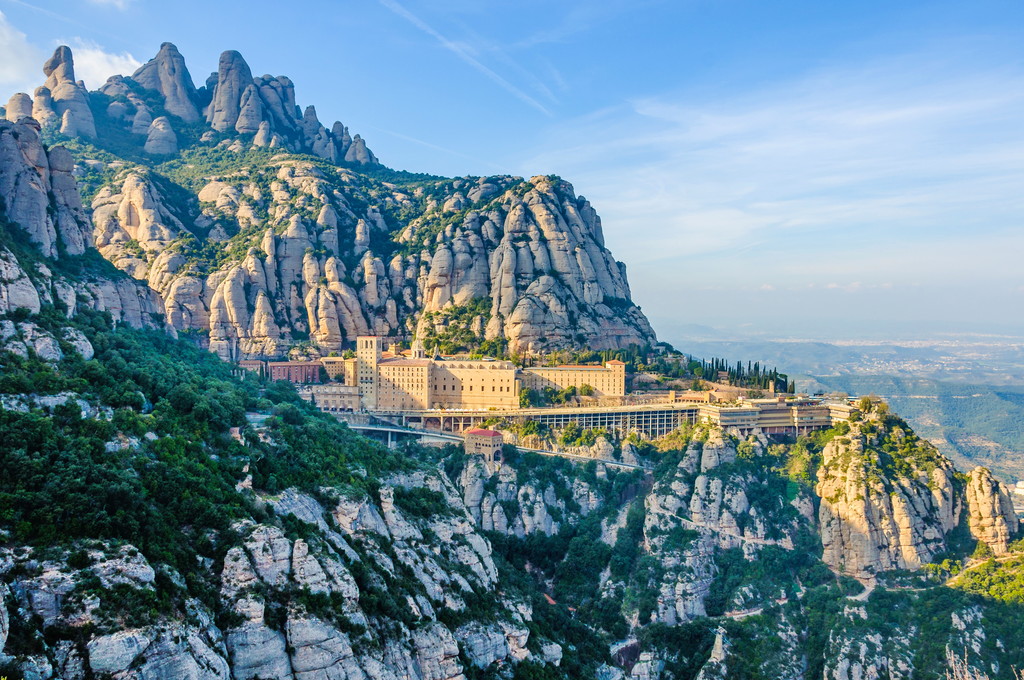Get PeakVisor App
Sign In
Search by GPS coordinates
- Latitude
- ° ' ''
- Longitude
- ° ' ''
- Units of Length

Yes
Cancel
Share ×

Scan the QR code and open PeakVisor on your phone
❤ Wishlist ×
Choose
Delete
Catalonia (Catalan: Catalunya, Spanish: Cataluña) is an autonomous community of Spain, encompassing the northeastern corner of the Iberian Peninsula. Catalonia’s rich culture and world-famous cities, coupled with the natural beauty of the Catalan Pyrenees, make it one of Spain's best hiking destinations. There are 9700 named mountains in Catalonia. Pica d'Estats (3,143 m / 10,311 ft) is the highest point, while Puigmal d'Err (2,909 m / 9,544 ft) is the most prominent mountain.
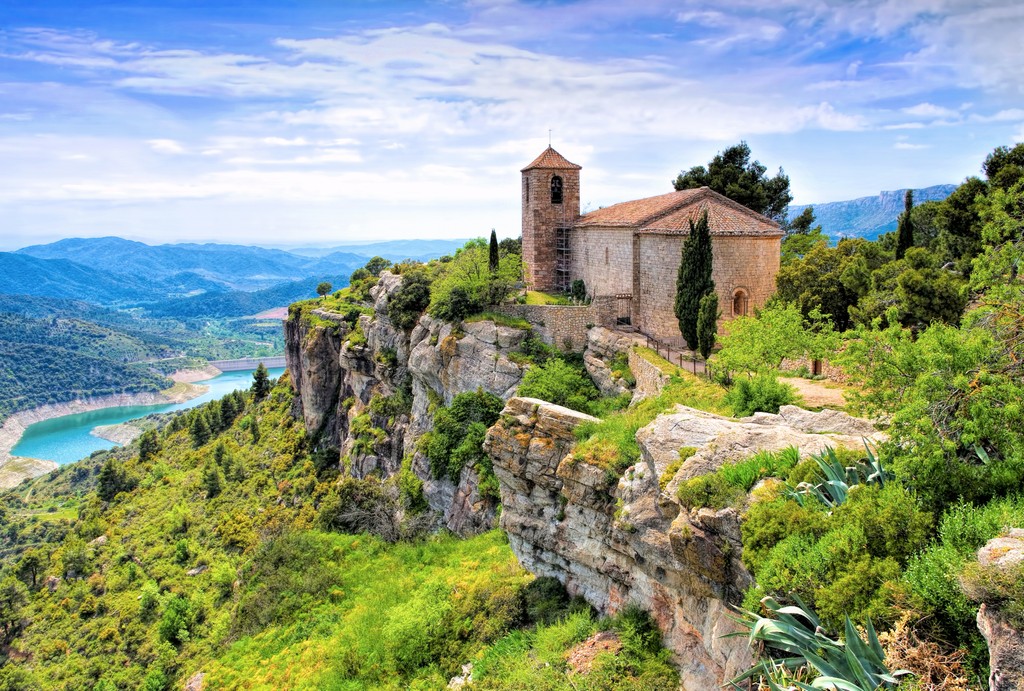
Covering an area of approximately 32,113 sq km (12,399 sq mi), Catalonia is Spain's 6th largest autonomous community, just a bit larger than Belgium. France's Occitanie region and the nation of Andorra border Catalonia to the north. The Spanish autonomous communities of Valencia and Aragon border Catalonia to the south and west, respectively. Catalonia features a 580 km (360 mi) coastline along the Mediterranean Sea.
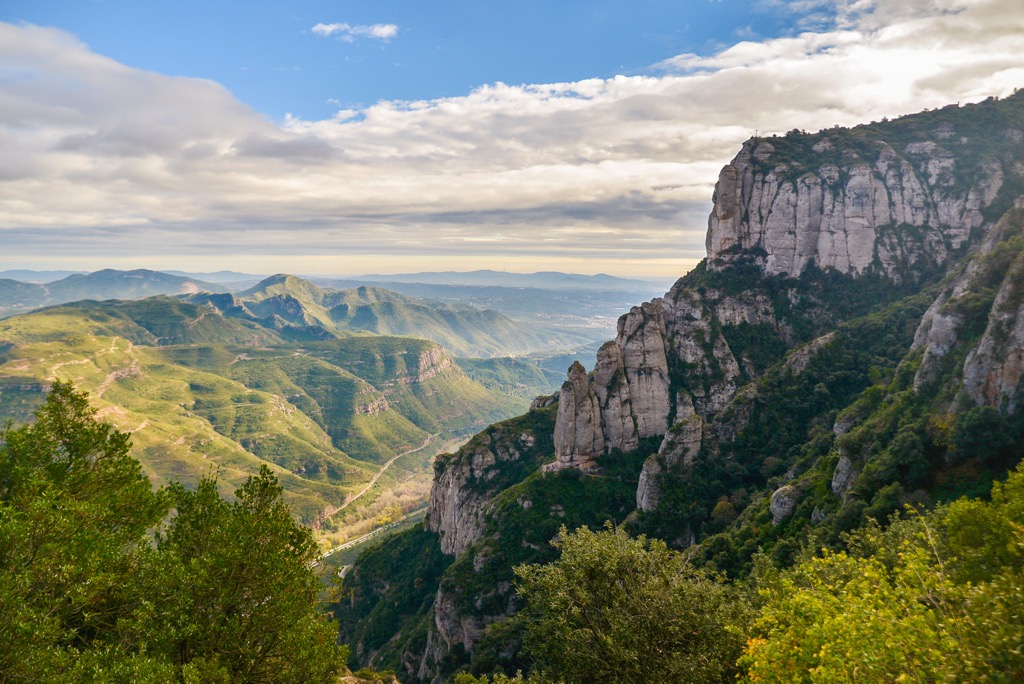
Catalonia comprises four provinces: Barcelona, Girona, Lleida, and Tarragona. Lleida is the largest province, covering an area of roughly 12,150 sq km (4,690 sq mi). Barcelona, with a population of over 5.7 million people, is the second-most populated province in Spain.
The 930 km (577 mi) long Ebro River is Catalonia's most significant waterway, flowing through eight towns in Tarragona. Lake Banyoles is Catalonia's largest natural lake, with a surface area of 1.57 sq km (0.6 sq mi).
Catalonia is home to 18 natural parks, including Cap de Creus Natural Park (Parc Natural del Cap de Creus), Aigüestortes I Estany of Saint Maurici National Park (Parc Nacional d'Aigüestortes i Estany de Sant Maurici), and Alt Pirineu Natural Park (Parque Natural del Alto Pirineo).

Topographically, Catalonia can be split into three regions: the Pyrenees, the Catalan Coastal Range, and the Catalan Central Depression.

Almost half of the Pyrenees mountain range sits within Catalonia. The 200 km (124 mi) long Catalan Pyrenees run across the region's northern edge, connecting with the Axial Pyrenees to the west. The Montcalm Massif and the Besiberri Massif are two of the most significant massifs in the Catalan Pyrenees.
The Pre-Pyrenees are foothills south of the Catalan Pyrenees with lower altitudes and different geological formations. Pica d'Estats is the highest mountain in the Catalan Pyrenees and the 35th highest summit in the entire Pyrenees range.
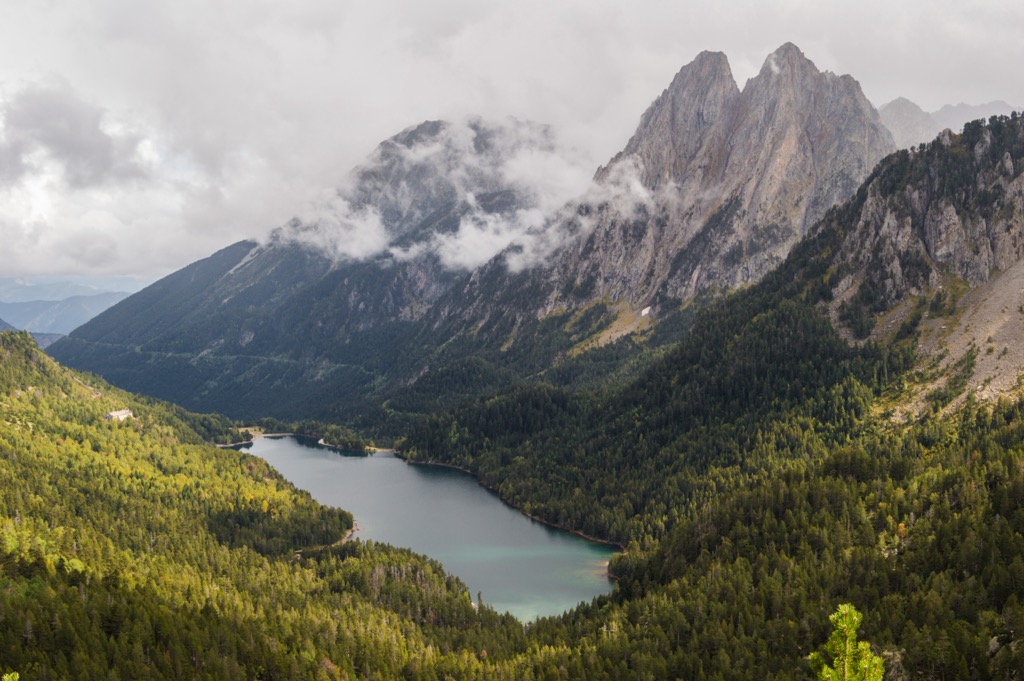
The Catalan Coastal Range is a series of mountain massifs parallel to Catalonia's Mediterranean coastline. The range is modest in height and never exceeds 800 m (2,624 ft) in elevation. The most significant area of the Catalan Coastal Range runs from the Gulf of Roses in Girona to the Foix River in Barcelona.
The Catalan Coastal Range consists of ten main massifs, including Montgrí, Massís de l'Ardenya, Sierra de Collserola, and Massís del Garraf. The famous Tibidabo (512 m / 1,680 ft), just outside Barcelona, is the highest mountain in the Sierra de Collserola.
Separating the Catalan Coastal Range and the Catalan Central Depression is the Catalan Pre-Coastal Range. The Catalan Pre-Coastal Range contains higher mountain massifs than the Catalan Coastal Range, including the famed Montserrat (1,236 m / 4,052 ft).
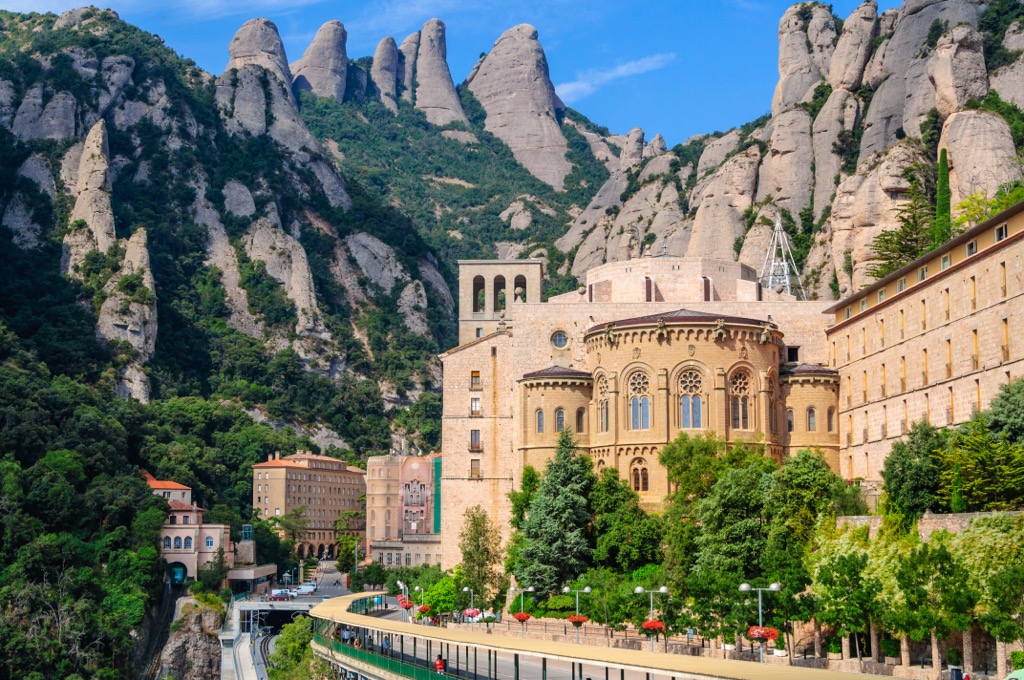
The Catalan Central Depression encompasses Catalonia’s central areas between the Pre-Pyrenees and the Catalan Coastal Range. It consists of plateaus between 800 m (2,624 ft) and 1,000 m (3,280 ft) in elevation, interspersed with river basins and irregular, isolated mountain massifs.
One well-known isolated massif in the Catalan Central Depression is Montmeneu (494 m / 1,623 ft), surrounded by flat plains. Several mountain massifs outside the Catalan Central Depression share the same geological make-up, such as Montserrat and Sant Llorenç del Munt (856 m / 2,808 ft).
The geology of Spain and the entire Iberian Peninsula is very complex, with a geological history spanning over 600 million years. The Iberian Peninsula sits on the Iberian Plate, which was once part of the African Plate but is now adjoined to the Eurasian Plate.
The Pyrenees, one of Catalonia's most famous geographical features, formed around 100 to 150 million years ago during the Alpine Orogeny. The Orogeny, which is still ongoing, is a mountain-building event caused by convergent movements between the African, Eurasia, and Indian Plates. These mountains span from Northern Africa to Southeast Asia and comprise the tallest peaks on Earth; the Orogeny is one of the defining geological features of our present era.

Tectonic forces are thrusting the Iberian Peninsula against modern-day France, compressing sedimentary rock layers. The eastern portion of the Pyrenees, which includes the Catalan Pyrenees, is composed primarily of granite and gneisses.
The Catalan Coastal Range and the nearby Iberian System (Sistema Ibérico) reflect the area between the African and Iberian Plates. The Catalan Coastal Range forms part of the Catalan Mediterranean System and contributed to the closure of the Ebro Basin. Its composition is varied, with Paleozoic and crystalline formations to the north and Mesozoic and tertiary formations to the south.
Mountain massifs are scattered across Catalonia, with all summits over 3,000 m (9,842 ft) high in the Catalan Pyrenees. Aside from Pica d'Estats, notable summits in Catalonia include Pic Verdaguer (3,129 m / 10,266 ft), Pedraforca (2,506 m / 8,222 ft), and Les Agudes (1,705 m / 5,593 ft).

From high in the Pyrenees to the central plains, Catalonia is home to a wide variety of flora and fauna.
The largest mammals found in Catalonia include wild boar, red deer, and recently reintroduced brown bears. High up in the Pyrenees, Pyrenean chamois are common. Other notable mammals include foxes, badgers, pine martens, hares, marmots, genets, and dormice. Several notable marine mammal species live off the coast of Catalonia in the biodiverse Balearic Sea, including sperm whales, pilot whales, and bottlenose dolphins.
Within Catalonia's forest and mountainous areas nest an array of bird species. Black woodpeckers, capercaillies, Tengmalm's owls, and crossbills are just a few of the species that inhabit Catalonia's most isolated woodlands.

Griffon vultures, bearded vultures, and golden eagles saw high over the Pyrenean slopes. Rock ptarmigans, snowfinches, and yellow-billed choughs are found in Catalonia's alpine pastures.
Catalonia is home to several significant amphibian and reptile species. One example is the Montseny Brook Newt, which is endemic to the Montseny Massif. The most common venomous snake in Catalonia is the asp viper. Other notable reptile and amphibian species include common frogs, Pyrenean newts, and smooth snakes.

A wealth of butterfly species are native to the region, including Iberian scarce swallowtails, Cleopatras, red admirals, and Old World swallowtails.
Catalonia is rich in plant biodiversity due to its geographical location and is home to well over 1,500 species. There are dozens of endemic species, over 100 of which are found in the Pyrenees, such as Pyrenean larkspurs, parsley of chamois, and Asplenium seelosii catalaunicum.

Flora on the slopes of the Catalan Pyrenees changes with elevation. Above 1,800 m (5,905 ft) in the montane zone, beech, downy oak, and Scots pine forests dominate the landscape. Between 2,300 m (7,545 ft) or 2,400 m (7,874 ft) in the subalpine zone, thick mountain pine and fir forests carpet the landscape.

Higher up in the alpine zone, the forests disappear and are replaced with alpine pastures and meadows. Here, grasses, shrubs, and alpine flora thrive, including fescue, nard grass, alpine gentians, and Pyrenean buttercups.
Some of the most common wild plants that grow in Catalonia include English ivy, golden pothos, rosemary, mastic trees, and laurustinus.
The earliest evidence of human settlements in Catalonia dates back to the Middle Paleolithic, over 50,000 years ago.

Catalonia shares much of its early history with the rest of Spain. By the 8th century BCE, Iberians occupied most of the Iberian Peninsula, with Greek colonies scattered along the coast. Ilergetes, Indigetes, and Lacetani people constituted the Iberians in Catalonia at this time. In the 3rd century BCE, the Carthaginians briefly ruled the region during the Second Punic War.
During Roman rule, Catalonia became the first part of the Iberian Peninsula colonized under the name Hispania. Tarraco, modern-day Tarragona, was one of the most important cities in Hispania. Hispania converted to Christianity by the 4th century CE and remained under Roman control until the fall of the Western Roman Empire in the 5th century.
Catalonia was part of the Visigothic Kingdom for over 250 years until it became part of the Islamic Umayyad Caliphate in 718. Following the siege of Barcelona in 801, Catalonia was controlled by the Frankish Kingdom. The earliest use of the term "Catalonia" originates from the name used for three vassal counties, which were part of the Frankish Kingdom.
By the late 11th century, the County of Barcelona had become increasingly independent and, in 1137, united with the Kingdom of Aragon. Under the Crown of Aragon, the Principality of Catalonia was established. Over the following centuries, the Principality of Catalonia was the base of the Crown of Aragon's Mediterranean trade routes.

In 1469, the King of Aragon, Ferdinand II, and the Queen of Castile, Isabella I, ruler of the rest of modern-day Spain, married. Both Aragon and Castile kept their independence but were ruled together. Historians see this as one of the most important events in the history of Spanish unification.

In 1516, Ferdinand II and Isabella I's grandson, Charles I of Spain, became the first monarch to rule Castile and Aragon simultaneously. He was also named Charles V, Holy Roman Emperor, in 1519. Over the following centuries, a series of war losses slowly moved power away from Catalonia and towards a centralized Spain.
During the Franco-Spanish War, Catalans revolted with French support due to heavy Spanish army presence, leading to the Reapers' War from 1640 to 1652. At this time, France briefly took control of Catalonia. Spain regained control of Catalonia while losing Roussillon and part of Cerdanya to France following the Treaty of the Pyrenees in 1659.
In 1700, Charles II of Spain died without an heir, leading to the War of the Spanish Succession. It was fought between Philip V of Spain of the French House of Bourbon and Austrian Habsburg Charles VI, Holy Roman Emperor. It ended with Philip V of Spain taking control of Aragon and Castile.
Catalonia supported the Habsburgs during the war, and following their defeat, Philip V of Spain incorporated Aragon and the Principality of Catalonia as provinces of Castile under Nueva Planta decrees. This was the first step towards a united Spain, pushing Catalan's culture and language to the sidelines. The aggressive nationalist policies that united the territories are still contentious today.

Catalonia was at the forefront of the Napoleonic Wars, and France annexed it between 1812 and 1814. Catalonia was also divided by a series of civil wars known as the Carlist Wars. During the late 19th century, Catalonia went through a period of rapid industrialization.
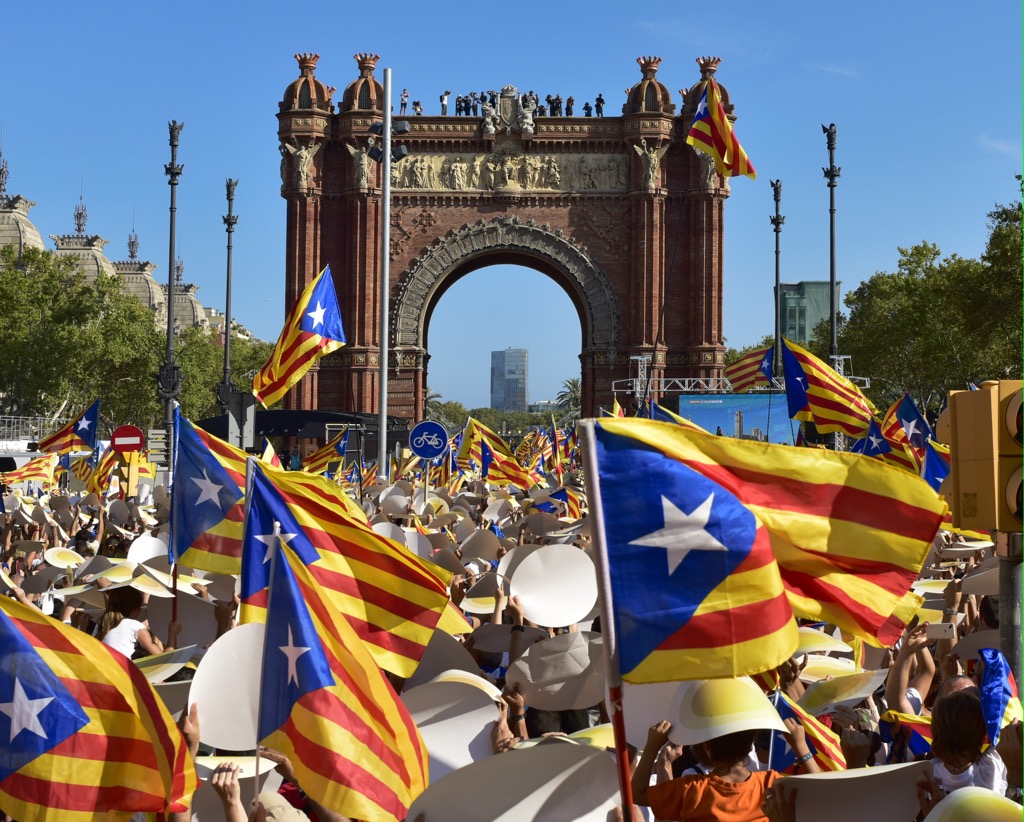
The Second Spanish Republic from 1931 to 1939 saw Catalonia's autonomous government restored. But, the Francoist dictatorship formed after the Spanish Civil War again removed Catalan autonomy and banned the Catalan language. Between 1975 and 1982, Spain transitioned to democracy, and Catalonia could self-govern again.
The Catalan independence movement has continued to grow in recent years. Following a 2017 referendum, Catalonia declared independence from Spain, a move the Spanish government didn't recognize as legitimate.
This independence referendum led to the removal of the Catalan government and a snap regional election. Several high-ranking officials, including Catalan President Carles Puigdemont, were imprisoned or fled Spain. The Spanish government pardoned those detained in 2021.

Catalonia has a strong economy, especially compared with the rest of Spain. Industrials are particularly strong (19% of GDP) in the region, with large companies like Dow Chemical and Volkswagon Group operating. Tourism comprises 12% of GDP. Notably, agriculture is still important, with many small farms in operation.
Most tourism is focused around the historic and stunning city of Barcelona. However, outdoor tourism is also important. You can find any type of outdoor recreation in Catalonia, but world-class hiking and rock climbing are particularly notable.

With the Pyrenees and the famed Montserrat Massif on your doorstep, Catalonia is home to some of Spain’s most famous hiking destinations.
Some of Catalonia's hikes, especially those high in the Pyrenees, are potentially dangerous. Ensure you map out your route carefully, inform others of your itinerary, and check local weather forecasts. Bring appropriate hiking gear and plenty of food and water.

Aigüestortes I Estany of Saint Maurici National Park (Parc Nacional d'Aigüestortes I Estany de Sant Maurici) is Catalonia's only national park. It's located in northwestern Lleida in the Central Pyrenees and covers approximately 408.5 sq km (157.7 sq mi).
The park is famed for being home to over 200 lakes as well as stunning mountains like Els Encantats (2,748 m / 9,016 ft). The park's highest summit is Comaloforno (3,029 m / 9,938 ft) in the Besiberri Massif.

One of the most popular day hikes in Aigüestortes I Estany of Saint Maurici National Park is the Estany de Sant Maurici - Amitges - Obagues de Ratera loop. This trail forms a part of the long-distance Carros de Foc, which many consider one of the most beautiful trails in Europe.
This trail runs along Estany de Sant Maurici's edge, providing one of the finest views of Els Encantats's twin peaks. Further along the route is the Estany de les Obagues de Ratera, with many picturesque waterfalls and lakes in the area.
The trail returns to its starting point from the Refugi d'Amitges (2,370 m / 7,776 ft). You can pick up this trail from the Prat de Pierró parking area. The route is approximately 17 km (10.5 mi) in length.
Some of the best mountains to climb in Aigüestortes I Estany of Saint Maurici National Park include Besiberri Sud (3,023 m / 9,918 ft), Tuc de Ratera (2,861 m / 9,386 ft), and Montardo (2,833 m / 9,295 ft).
Alt Pirineu Natural Park (Parc Natural de l'Alt Pirineu) is the largest natural park in Catalonia, encompassing an area of approximately 698.5 sq km (269.7 sq mi). It's located in northeastern Lleida and includes Catalonia's highest Pyrenean summits. The park is home to over 140 glacial lakes.
Pica d'Estats, Catalonia's highest summit, is emblematic of Alt Pirineu Natural Park and one of the park's most popular mountains. Pica d'Estats is a demanding hike, with several routes available. Many trails cross the border from Spain into France.

One popular route is approaching from the south from Refugi di Vallferrera (1,940 m / 6,365 ft). This route passes several lakes, including Estany d'Estats, and can be used to access several other peaks like Pic du Montcalm (3,077 m / 10,095 ft). This out-and-back trail is approximately 18.3 km (11.3 mi) in length.
Some of the other best mountains to climb in Alt Pirineu Natural Park include Pic Verdaguer (3,129 m / 10,266 ft), Monteixo (2,905 m / 9,531 ft), and Pic de la Gola (2,544 m / 8,346 ft).

Montserrat Mountain Natural Park (Parc Natural de la Muntanya de Montserrat) is located in Barcelona, covering an area of approximately 36.3 sq km (14 sq mi). It centers around the Monserrat, a mountain range with unique formations home to the iconic Benedictine Monestir de Montserrat.

Montserrat is one of Catalonia's most beautiful geographical features and is an excellent destination for hikers of all abilities. One of Montserrat Natural Park's most popular trails is the Sant Jeroni Summit Loop.
The Sant Jeroni Summit Loop leads up Saint Jeroni (1,235 m / 4,052 ft), Montserrat's highest peak. You'll be treated to panoramas of the entire range from the summit, with the Pyrenees visible in the distance. You can pick the trail from the Benedictine Monestir de Montserrat. This looped trail is approximately 10.3 km (6.4 mi) in length.
Another popular trail in Montserrat Mountain Natural Park is the Santa Maria de Montserrat–Creu Sant Miquel–Ermita Mare de Deu de la Salut. The trail leads from the town of Collbató to the Santa Maria de Montserrat Abbey. This looped trail is approximately 13.4 km (8.3 mi) in length.

Cadí-Moixeró Natural Park is a natural park tucked away in the northeastern corner of Lleida on the Andorran border, covering an area of approximately 410 sq km (158 sq mi).
The park centers around some of the highest and most beautiful mountains in the Pre-Pyrenees, including Pedraforca. It takes its name from the El Cadí and Moixeró mountain ranges. The park's highest summit is Vulturó (2,648 m / 8,688 ft).

Pedraforca is an iconic Catalan mountain and a must-climb for serious hikers. Lots of experience and a head for heights are essential when attempting Pedraforca.
One of the most popular ascents of Pedraforca is on the PR-C 123 loop from the Gresolet viewpoint (Mirador de Gresolet). This trail leads over the Pollegó Inferior del Pedraforca (2,444 m / 8,018 ft), which provides one of the best views of Pedraforca's true summit. This trail loop is approximately 8 km (5 mi) in length.
Some of the other best mountains to climb in Cadí-Moixeró Natural Park include La Tosa (2,536 m / 8,320 ft), Penyes Altes de Moixero (2,276 m / 7,467 ft), and Gallina Pelada (2,321 m / 7,615 ft).
Serra de Collserola Natural Park (Parc Natural de la Serra de Collserola) is located around 10 km (6 mi) northwest of downtown Barcelona, covering an area of approximately 81.7 sq km (31.5 sq mi). The park's main feature is the Serra de Collserola, a mountain range within the Catalan Coastal Range.
The largest green space in metropolitan Barcelona, Serra de Collserola Natural Park is hugely popular with hikers searching for panoramas of the city's skyline.

Tibidabo (512 m / 1,680 ft) is the park's highest and most famous summit. It's topped with a minor basilica, Sagrat Cor church, and the Tibidabo Amusement Park. There are several ways to reach the summit including driving or riding the Tibidabo Funicular, but hiking is much more rewarding.
It's possible to spot many landmarks from the summit of Tibidabo, including Montserrat to the northwest and Barcelona's tallest building, Collserola Tower. One of the best ways to climb Tibidabo is from the Passeig de les Aigües car park. This looped trail is approximately 6.4 km (4 mi) in length.
Other popular Serra de Collserola Natural Park summits include Turó de Miralluna (476 m / 1,562 ft) and Puig Madrona (356 m / 1,168 ft).
Barcelona is the capital of Catalonia and the second-largest city in Spain. Barcelona's Gaudí architecture, remarkable coastline, and vibrant nightlife make it one of Europe's most exciting and impressive cities.
Barcelona has no shortage of world-class attractions, from the one-of-a-kind La Sagrada Familia to the bustling Mercado de La Boqueria. Plus, Barcelona serves as a superb hiking hub, with several parks, including Montserrat Mountain Natural Park, Sant Llorenç del Munt I l'Obac Natural Park, and Serra de Collserola Natural Park, less than 45 km (28 mi) away.
Josep Tarradellas Barcelona–El Prat Airport, the second-largest airport in Spain, is located 15 km (9.3 mi) southwest of downtown Barcelona.

Lleida is the capital of the Lleida province in Catalonia's northwestern corner. Lleida is one of Catalonia's largest metropolitan areas, with over 140,000 people.
Lleida is one of Catalonia's oldest settlements, dating back to the Bronze Age. Lleida is a Catalan-speaking city, and most people are bilingual, making it a great spot to soak up the local language. One of the top attractions in Lleida is the Cathedral of St. Mary of la Seu Vella, which overlooks the city.
Lleida–Alguaire Airport, a regional airport, is located approximately 15 km (9.3 mi) from Lleida.

The coastal city of Tarragona is the capital of the province of the same name, located in southern Catalonia. It's a city renowned for its fantastic beaches, historic landmarks, and Catalan culture.
Tarragona has ties to the Roman Empire, with several fascinating Roman landmarks like the Amfiteatre de Tarragona, Circ Romà, and Ferreres Aqueduct. Several natural parks, like Serra de Montsant Natural Park, surround Tarragona, making it a popular hiking destination.
Reus Airport, an international airport, is located roughly 8 km (5 mi) from the center of Tarragona.

Girona is a city located in northeastern Catalonia and is the capital of Girona province. It's a popular tourist destination due to its architectural beauty and has been a filming destination for many TV shows and movies, including Game of Thrones.
With attractions like the Basílica de San Félix, the Banys Àrabs, and Girona Cathedral, Girona is an excellent destination for history buffs. It's also a stone's throw from popular hiking areas, including the Alta Garrotxa.
Girona–Costa Brava Airport, an international airport, is located 12.5 km (7.8 mi) southwest of Girona.

Explore Catalonia with the PeakVisor 3D Map and identify its summits.
